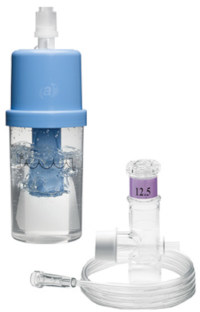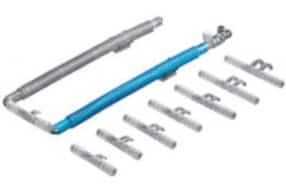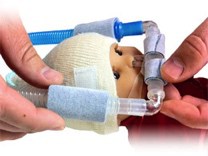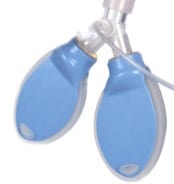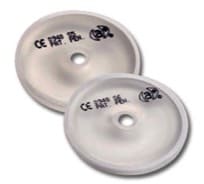Babi.Plus® Bubble PAP Valve
The Respiralogics Babi.Plus Bubble CPAP Valve provides a convenient method of delivering continuous PAP (positive airway pressure) to infants weighing less than 10 kg. The patent-pending design delivers accuracy and stability throughout the infant’s course of therapy, freeing the clinician to focus on patient care.
The Babi.Plus Bubble PAP Valve was the first to receive FDA 510k market clearance for delivery of positive end expiratory pressure in patients weighing less than 10 Kg in hospital environments to increase end lung pressure above atmospheric in a constant flow condition. The PAP is adjustable from 1 to 10 cm H2O, using gas flows from 1 to 12 liters per minute for precise pressure delivery. The Bubble CPAP Valve’s ergonomic design allows pressure to be easily set without the cumbersome and time consuming tasks normally associated with bubble devices.
Respiralogics Baby Nose Bumper and Circuit Bumpers
Baby Nose Bumper and Circuit Bumpers allow optimal fixation of the Nasal Prongs for infants.
Circuit Bumpers firmly attach the inspiratory and expiratory limbs to the Baby Cap cushioning the infant from the breathing circuit. Baby Nose Bumper and Circuit Holders are single-patient use items. Baby Nose Bumper and Circuit Bumpers allow optimal fixation of the Nasal Prongs for infants
The skin friendly Baby Nose Bumper mustache is made of RespiraGel™, our new “skin friendly” hydrocolloid based adhesive. The baby nose Bumper gently holds the nasal interface to the mustache providing a secure grip and gentle cushion for the nares.
Babi.Plus™ nTest Lung is an easy to use neonatal test lung for demonstration and testing applications with infant and neonatal ventilator support devices.
The Sil.Flex TC Pad design allows for placement of the Pad on the trach tube at the time of the procedure. Early use of the TC Pad may assist in reducing irritation and tissue breakdown at the stoma site as well stabilize the tracheostomy tube. Use of the TC Pad may decrease the air leak around the stoma site during trach weaning or during speech therapy by improving the seal between the pad the stoma.
